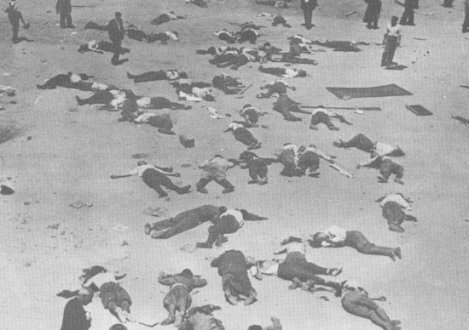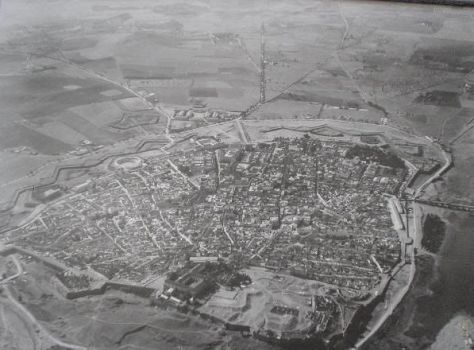The Battle of Badajoz was one of the first leading battles, and victories, for the right-wing Nationalist rebels in the Spanish Civil War. Won on 14 August 1936, the massacre at Badajoz has long been used as propaganda against the cruel Franco forces.
 The war was almost one month old. Areas controlled by Nationalist armies were fractured between north and south, and needed to connect their territories. Badajoz, a town of around 41,000, on the border with Portugal, became a prime target. Nationalist forces set out north from Seville on their way towards central Madrid. By August 10, Colonel Juan Yague (a notorious killer, especially of innocents) and his 2250 troops had taken the town of Mérida, just 60 km east from Badajoz. Yague had orders to take Badajoz to help link their north and south frontiers and have the area next to the Portuguese border under their control.
The war was almost one month old. Areas controlled by Nationalist armies were fractured between north and south, and needed to connect their territories. Badajoz, a town of around 41,000, on the border with Portugal, became a prime target. Nationalist forces set out north from Seville on their way towards central Madrid. By August 10, Colonel Juan Yague (a notorious killer, especially of innocents) and his 2250 troops had taken the town of Mérida, just 60 km east from Badajoz. Yague had orders to take Badajoz to help link their north and south frontiers and have the area next to the Portuguese border under their control.
Badajoz was already flooded by refugees from all directions from killings happening in both towns and in the country. Some rich right-wing landowners were even holding days when they and their friends would go killing peasants while on horseback. Killings and reprisals killings were uncontrolled and widespread. For three days, Badajoz suffered aerial bombing from planes donated to the Nationalist troops from Italy and Germany. The town’s mood was one of impending doom.
After dawn on 14 August, the Nationalists stormed the north gate of the city, Puerta de Los Carros, and the south gate, Puerta de la Trinidad. While the Republicans managed to hold back the soldiers at the south gate, the brutal Moorish troops won at the north gate, breaching the city and overcoming the barracks inside. An ugly battle ensued, with the Nationalists killing with bayonets and knives as they overtook the whole town. Many Republican militia defected to join the Nationalist troops, and many surrendered. Everyone in sight was killed throughout the day, even when surrendering. All the leaders of the town and Republican militia, including the mayor, had left the town early in the day and made it to Portugal, abandoning the people to their deaths.
The Nationalist troops took much delight in slaughtering as many people as possible, including unarmed women and children. Their leaders had been promoting the use of rape against women as a weapon from the outbreak of war as well. Anyone who wasn’t immediately killed on sight was rounded up. While many were marched to the local bullring and executed by firing squads, many were simple killed on the street. Estimates of between 1000 and 1800 people were executed on the first day of fighting. In one main street, Calle San Juan, around 300 bodies were left there after execution. Through the night and into the next day, anyone even suspected of being a left-wing sympathiser was taken from their homes and sent to the bullring for execution. Journalists ran censored stories about the massacre, including a Portuguese journalist, who fled home with the story, refusing to ever set foot in Badajoz ever again after witnessing torture and execution.
The true death toll of the Badajoz massacre remains unknown, but estimated somewhere between 1300 and 4000 people. No official death toll was taken. Most were killed by firing squad or machine gun fire in the bullring, to the point where prisoners stood ankle-deep in blood with other bodies as they were murdered. Reports of mutilation were made, though exact behaviour is unknown. It was suggested that some were killed bullfight style, chased around and stabbed in the back and then mutilated. The Moorish troops were well-known for their vicious and sadistic nature. Up to 10% of the town died in this one battle.
 An early photo of inside the bullring
An early photo of inside the bullring
The battle of Badajoz gave one of the war’s most famous quotes, when Colonel Yague, who by then had earned his ‘Butcher of Badajoz’ nickname, told an American journalist (with much pride) – “Of course we shot them. What do you expect? Was I supposed to take 4,000 reds with me as my column advanced, racing against time? Was I expected to turn them loose in my rear and let them make Badajoz red again?” While the battle is labelled as fighting during a war, much has been said about reclassifying it genocide or a crime against humanity, which it most certainly was.
Around the Badajoz region, another 2000 people were killed by the marching soldiers, mostly farmers. While the Republicans were labelled ‘reds’, the Nationalists were now known as the ‘white terror’. Sadly this was only the start of a long civil war.
 Firing squad against the wall outside the bullring
Firing squad against the wall outside the bullring
The leaders of the defense committee and the mayor were found in Portugal and returned home to face execution a short time later. This battle would be far from Badajoz’s only major battle during the war. But this initial massacre linked the north and south elements of the Nationalists, strengthening their advance on the country.
~~
This is not a detailed analysis, instead a simplified report of events in Badajoz. Feel free to suggest an addition/clarification/correction below. All photos are linked to source for credit. Against usual preference, I chose to add the firing squad photos as it is a painfully accurate reflection of the event.

